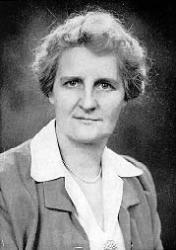


Avis Marguerite Burgeson Christiansen
Repertoire:
Blessed Redeemer
Love Found a Way
It is Glory Just to Walk With Him
Only One Life
How Can It Be?
Up Calvary's Mountain
(October 1895 – January 1985)\
Avis Marguerite Burgeson was born on October 11, 1895, in Chicago. Not much is known about her childhood or her education except that she spent her life in and around the northern Chicago communities. She was a modest and retiring woman and sometimes used pen names such as Avis Burgeson, Christian B. Anson, and Constance B. Reid to divert attention from herself. She attended the Moody Church where her pastor was Dr. Harry A. Ironside from 1929 to 1948.
Born into a Christian home where whole-hearted service of Christ was accepted as the natural thing, Avis became a Christian at an early age. She once stated that the wonder of salvation in her own life was the source for the beautiful verses that continue to draw others close to her Savior. As a child, Avis was very influenced and encouraged by her grandmother. She was a strong Christian woman who loved music and would sing the old church hymns to Avis to pass the time. Avis began writing poems in childhood with her encouragement and she wrote her first poem at age ten.
Avis joined with the Moody Church in Chicago in 1915 where she met, fell in love with, and married Ernest C. Christiansen in 1917. He later became Vice President in charge of investments for Moody Bible Institute. They were eventually blessed with two daughters and despite being a busy wife and mother, she continued to write poetry and hymns. Avis once said that her hymns had come from her own life experiences with the Lord.
In addition to her many hymns and songs, Avis wrote and published two books of poetry. The first, His Faithfulness in 1949, and Avis Christiansen’s Most-Loved Poems in 1962. One of the greatest compliments to be paid Avis was written in the forward to her first book of poetry, His Faithfulness, by her pastor and author, H.A. Ironside: “Avis B. Christiansen is the gifted author of many of our sweetest gospel songs. By means of these, her name is known around the world, for many of the delightful lyrics have been translated into various languages. She is a modest, retiring person whom few got to know beyond the circle of her immediate family and friends. With a very keen apprehension of spiritual realities and a clear understanding of the great truths revealed in the Word of God, her hymns and poems are eminently Scriptural and soul-uplifting.”
It was her involvement with Moody Church that led to her life’s work. She recorded that on one Sunday morning it seemed that everything that happened or was said reminded her that the talent that she was blessed with belonged to her Lord. She developed a longing to express His love and blessing which resulted in her first two hymns. One of these was set to music by D.B. Towner, Director of Music at Moody Bible Institute. It is titled, That Is Far Enough for Me and is based upon Psalm 103 with David praising God that he would not be dealt with as his sins required but as verse 12 states: “As far as the east is from the west, So far hath He removed our transgressions from us.” Many of her early efforts were set to music and sung by The Moody Church choir.
It was during this time that she realized her need for deeper grounding in the Word of God, so she began to study at the Moody Evening School. Mrs. Christiansen took no credit for her poems. She was constantly amazed that her words bore such abundant fruit. She always credited the fact that her songs and poems were doctrinally correct from her study at the school. This solid, fundamental background deepened her devotion to God and to the work He had given her to do. Her testimony was: “I have been able, by His infinite grace, to pour out my soul in hundreds of songs of praise to my blessed Redeemer. He speaks through the commonplace things of life, if we are but listening for His gentle voice. All I need to know of heaven is that Jesus will be there.”
One of her first songs that has remained popular through the years is Blessed Redeemer. It was written in 1920 and the music was composed by Harry Dixon Loes. He had studied music at Moody Bible Institute. After finishing school, he served several churches in the music ministry and from 1939 until his death in 1965, he was a member of the Faculty of Moody Bible Institute. It very seldom happens in this order, but one day while listening to a sermon about Christ’s Atonement entitled Blessed Redeemer, Loes was inspired to compose the tune which he named, Blessed Redeemer. Not having any idea for appropriate words, he sent the melody with the suggested title to Mrs. Christiansen and asked her to write suitable lyrics to fit the melody. The completed hymn first appeared in the hymnal, Songs of Redemption, in 1920. It is one of my favorite songs and it is safe to say that the song has remained a congregational favorite through the years.
Blessed Redeemer! Precious Redeemer!
Seems now I see Him on Calvary’s tree;
Wounded and bleeding,
for sinners pleading,
Blind and unheeding–dying for me!
Another of her wonderful songs, published in 1961, is How Can It Be?
O Savior, as my eyes behold
The wonders of Thy might unfold,
The heavens in glorious light arrayed,
The vast creation Thy hast made–
And yet to think Thou lovest me–
My heart cries out, ‘How can it be?’
How can it be? How can it be?
That God should love a soul like me,
O how can it be?
These are two wonderful, heart-felt songs to bookend her life. In this song, she alludes to the glorious privilege given to man. That God should love and honor such poor creations of dust, and to be the crown of God’s creation on the earth, is beyond comprehension. The music was written by John W. Peterson.
Bibliography
www.hymntime.com
www.hymnary.org
www.moodymedia.org
Hymns of Our Faith, William J. Reynolds
Harry Dixon Loes lived from 1892 to 1965. He wrote and composed many songs and hymns during his career. He was also involved in creating and writing children’s songs for Sunday School. The man who wrote the music for Blessed Redeemer is also credited with writing the words and music for This Little Light of Mine sometime in the early 1920’s. It became a staple of Sunday School teaching across the U.S.
John Willard Peterson lived from 1929 to 2006. Peterson served as an Army Air Force pilot flying the China Hump during World War II. After the war, he attended MBI and served on the radio staff there for several years. He graduated from the American Conservatory of Music in Chicago in 1953 and settled in Pennsylvania. He later moved to Grand Rapids, Michigan, where he was President and Editor-in-Chief of Singspiration. During that time, he compiled and edited Great Hymns of the Faith. He wrote over 1000 songs, and 35 cantatas including It Took a Miracle, Over the Sunset Mountains, Heaven Came Down, So Send I You, Springs of Living Water, Jesus is Coming Again, Surely Goodness and Mercy, and This is the day that the Lord hath made.
